You could spend a lifetime among Tucson’s saguaros and still find new views. You’ll hike prickly canyons, taste Sonoran tacos, catch a desert sunset from Gates Pass, and trace history from Mission San Xavier to the Presidio—yet there’s more that makes this city surprising and easy to love, so keep going to see the 25 best things that will shape your trip.
Hike in Saguaro National Park
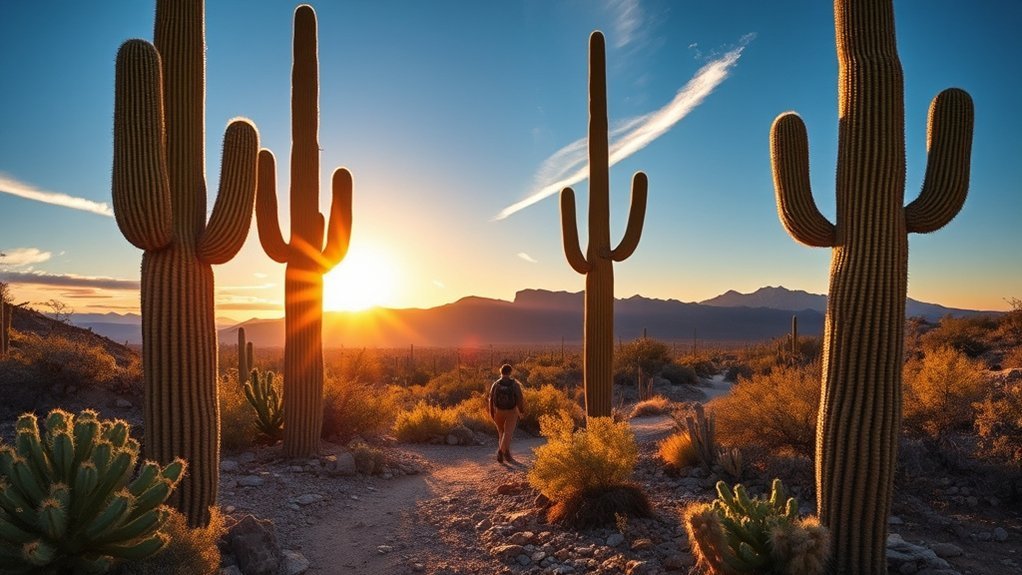
Often you’ll find the desert’s silence broken only by your boots on the trail as you hike in Saguaro National Park. You’ll move among towering saguaros that reshape with the sun, their arms casting long, deliberate shadows. As you climb gentle washes and ridgelines, you’ll notice bees on brittle flowers, lizards slipping between rocks, and distant city haze framed by cactus silhouettes. Choose a loop that matches your stamina—short trails offer close-up views and interpretive signs, while longer routes give panoramic views of Tucson and surrounding ranges. Carry water, a hat, and layered clothing; temperatures shift quickly. Rangers post seasonal tips and maps at trailheads, so you’ll want to check for closures or guided walks. Photography is rewarding at golden hour, when skeleton-like cacti glow. You’ll leave with a clear sense of place: an arid landscape alive with subtle motion, geological time, and plants adapted to make the most of rare rain.
Explore Tucson’s Historic Fourth Avenue
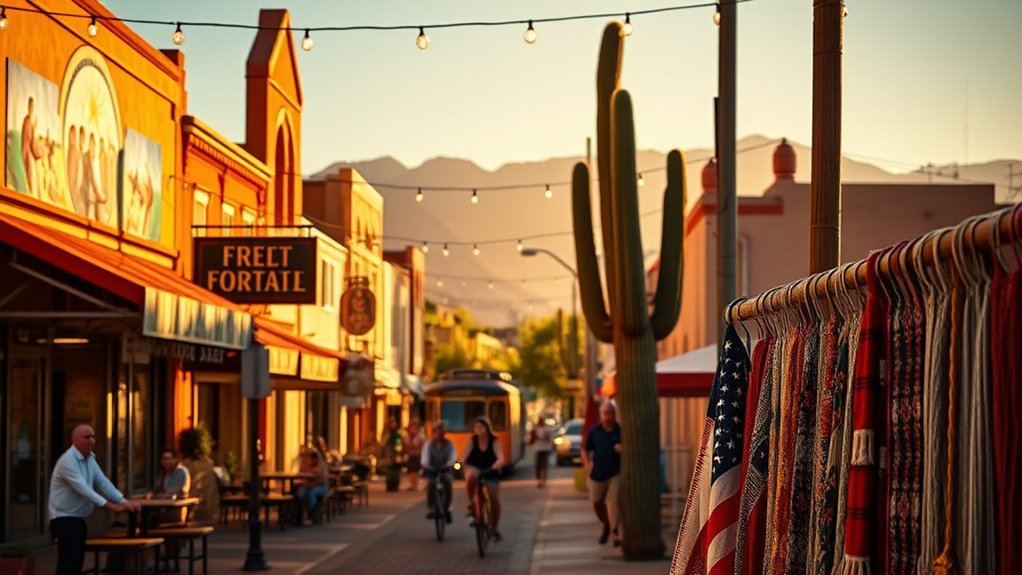
Stroll down Fourth Avenue and you’ll find a lively strip of independent shops and boutiques where handcrafted goods and vintage finds beckon you to browse. When your feet need a break, pop into one of the neighborhood’s bars or eateries for a cold drink or a plate of Sonoran-inspired fare. The street’s mix of colorful storefronts and relaxed nightlife makes it an easy, rewarding stop on a Tucson day or evening.
Shops and Boutiques
When you step onto Fourth Avenue, you’ll feel the neighborhood’s creative pulse—independent shops, vintage boutiques, and artisan stalls line the brick sidewalks and spill color onto the streets. You’ll wander past storefronts showcasing handmade jewelry, Southwestern textiles, and locally printed posters, each window a small story about Tucson makers. Stop to chat with shop owners; they’ll point out seasonal artisans, gallery openings, or a rare vintage find tucked on a high shelf. You can compare pottery glazes, try on curated clothing, or flip through vinyl records in a sunlit nook. Pay attention to shop hours and gallery nights—markets and pop-ups often change. Fourth Avenue’s retail scene rewards slow exploration: you’ll leave with unique souvenirs and a clearer sense of the city’s creative community.
Bars and Eateries
After you’ve poked around the shops and chatted with makers, Fourth Avenue’s bar and food scene invites you to linger and taste the neighborhood. You’ll find dive bars humming with locals, cozy patios perfect for people-watching, and restaurants blending Sonoran flavors with modern craft. Walk in hungry: street tacos, seasonal salads, and smoky mesquite grilled plates map the area’s honest flavor. Bartenders’ll share stories about neighborhood history while pouring creative cocktails or local brews. Sit, listen, and let the evening unfold—live music drifts, laughter rises, and you pick a favorite corner. Practical tip: arrive early for patio seats and try a shared plate to sample more without overfilling.
| Flavor | Ambience | Memory |
|---|---|---|
| Bold | Intimate | Warm |
| Spicy | Lively | Easy |
Visit the Arizona-Sonora Desert Museum
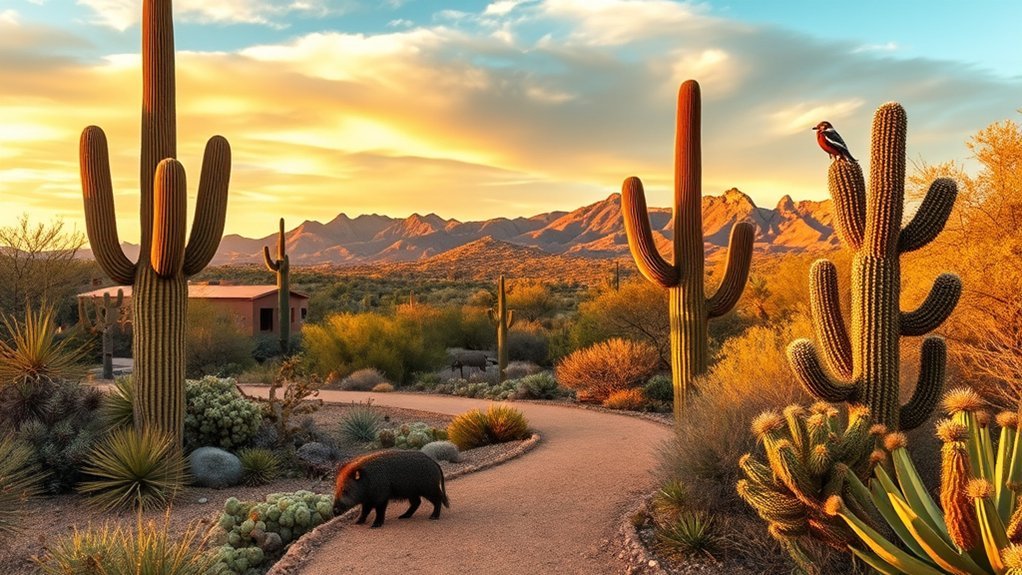
When you walk into the Arizona-Sonora Desert Museum you’ll see live desert animals moving through recreated habitats, from coyotes to raptors. You’ll learn how native plants shape the landscape and support wildlife, with labeled gardens that make it easy to recognize species. The museum feels like a guided field trip, blending up-close encounters with clear explanations about desert ecology.
Live Desert Animal Encounters
Step into the Arizona-Sonora Desert Museum and you’ll find more than exhibits — you can watch desert animals up close and learn how they live in this harsh landscape. You’ll follow handlers as they introduce raptors, bobcats, coyotes, and reptiles, noting behaviors you wouldn’t spot on a casual hike. Guides explain diet, hunting strategies, and seasonal adaptations while you observe talons, whiskers, and scaled skin in detail. Demonstrations often include flight or feeding sessions that highlight sensory skills and energy conservation. Encounters are educational and respectful: animals aren’t props but ambassadors for conservation, and staff prioritize welfare. You’ll leave with clearer understanding of how these species survive and why protecting their desert home matters.
Native Plants and Habitats
Beyond watching animals up close, the Desert Museum invites you to explore the plants and habitats that make those encounters possible. You’ll walk winding trails where saguaros, ocotillos, and palo verdes punctuate the skyline, and interpretive signs explain survival strategies—water storage, spines, and seasonal growth. As you move from rocky uplands to thorn scrub and riparian corridors, you’ll notice subtle shifts in soil, color, and scent that dictate which species thrive. Docents point out nurse plants protecting young cacti and demonstrate how native grasses stabilize slopes. You can join guided habitat tours and seasonal plant walks to see blooms and seed dispersal in action. The experience clarifies how plants structure desert life and why conserving those habitats matters.
Tour Mission San Xavier Del Bac
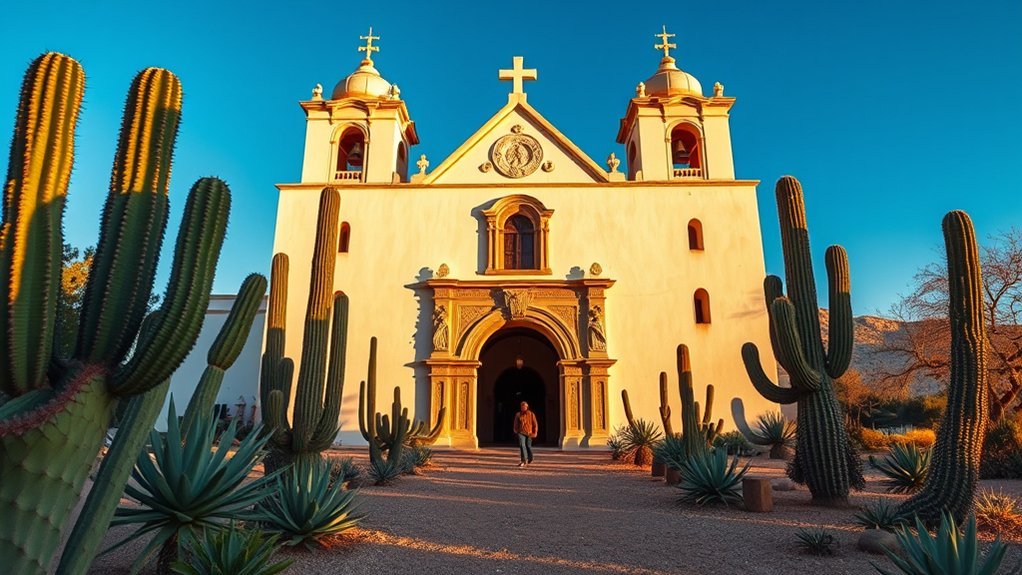
Tucked just south of Tucson, Mission San Xavier del Bac greets you with its white stucco walls and ornate Baroque interior—a living snapshot of 18th-century Spanish colonial and Tohono O’odham history. You step across the courtyard and feel the scale shift: low desert sun outside, cool shadowed frescoes inside. Guides point out painted angels, carved saints, and the layered craftsmanship that blends European techniques with Indigenous motifs. You’ll notice the ongoing role the mission plays for the Tohono O’odham community—feasts, ceremonies, and daily prayers keep the place alive. Photography is welcome but respectful silence matters during services. Take time to walk the grounds, read the historical plaques, and visit the small gift stall run by local artisans. If you go in the late afternoon, the façade glows warm against the desert sky, offering a calm moment before you return to town.
- sunlit white façade and sculpted towers
- shadowed nave with vivid frescoes
- carved wooden saints with intricate paint
- courtyard agave and low stone walls
- local artisans’ woven crafts and rosaries
Stroll Through Sabino Canyon
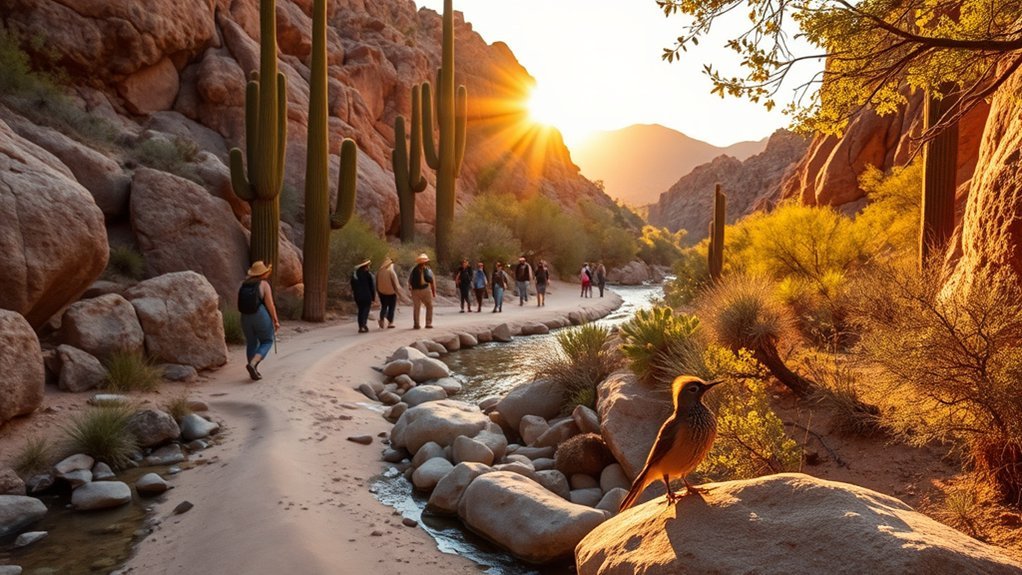
You’ll find Sabino Canyon’s scenic trails weave through boulder-strewn washes and shady cottonwood groves, making every step feel like a small discovery. You can hike quiet footpaths or hop the narrated shuttle and tram to reach higher viewpoints without wearing yourself out. Bring water, a hat, and your camera — the canyon’s vistas change with the light.
Scenic Canyon Trails
Along the foot of the Santa Catalinas, Sabino Canyon welcomes you with sunlit washes, cottonwoods, and a steady chorus of birdsong as the paved tram road gives way to winding dirt paths. You choose a route by feel—some easy, some steep—and the canyon unfolds: seasonal pools mirror cliffs, desert scrub yields to shady riparian pockets, and granite steps test your footing. You’ll notice lizards skitter, the scent of creosote after a light rain, and the way light slants through palo verde. Trails are well-marked; bring water and steady shoes. Move at your own pace, pause at viewpoints, and respect fragile plants. Below are images to guide your imagination:
- Golden light on saguaros at dawn
- Moss-lined pools after monsoon
- Narrow rock staircases
- Cottonwood shade along the wash
- Distant Catalina ridgeline silhouette
Shuttle and Tram Options
Hop on the Sabino Canyon shuttle or hop off to explore on foot—the tram and shuttle system gives you flexible access to the canyon’s trailheads without worrying about parking. You’ll ride narrated trams that pause near popular trailheads and scenic overlooks, so you can plan stops by difficulty and distance. Tickets are timed; buy them early in peak season or reserve online to avoid disappointment. Drivers point out geology, wildlife, and seasonal blooms, which helps you choose where to hike next. If you prefer solitude, take a later stop and walk back along paved segments. Service runs most of the year but check schedules for closures after storms. The system makes the canyon approachable whether you’ve come to stroll, photograph, or summit.
Watch the Sunset at Gates Pass
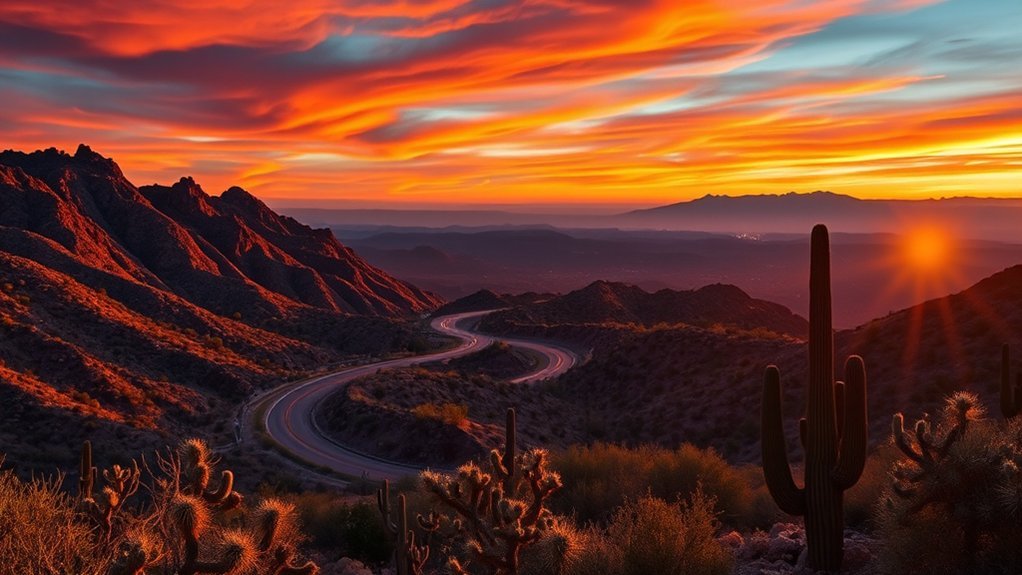
Drive up to Gates Pass as the day winds down and you’ll find the desert putting on one of Tucson’s most vivid sunset shows. You’ll park along the overlook, step out into warm, thinning air, and watch light carve the jagged silhouettes of the Tucson Mountains. The sky shifts fast — gold to tangerine to bruised purple — and you’ll notice how long shadows ribbon across creosote and saguaros. Locals bring blankets and cameras; couples linger; photographers hunt angles. You’ll get practical tips too: arrive 30–45 minutes before sunset for a good spot, bring water and a jacket for cooler evenings, and leave promptly if the lot fills.
- A lone saguaro framed against a blazing horizon
- Sunlight pooling in washes and highlighting red-rock textures
- Birds winging home through streaked clouds
- Cooling air smelling faintly of creosote
- Headlights threading the winding washboard road
Gates Pass teaches you patience and rewards a quiet, panoramic farewell to the day.
Discover the University of Arizona Campus and Museums
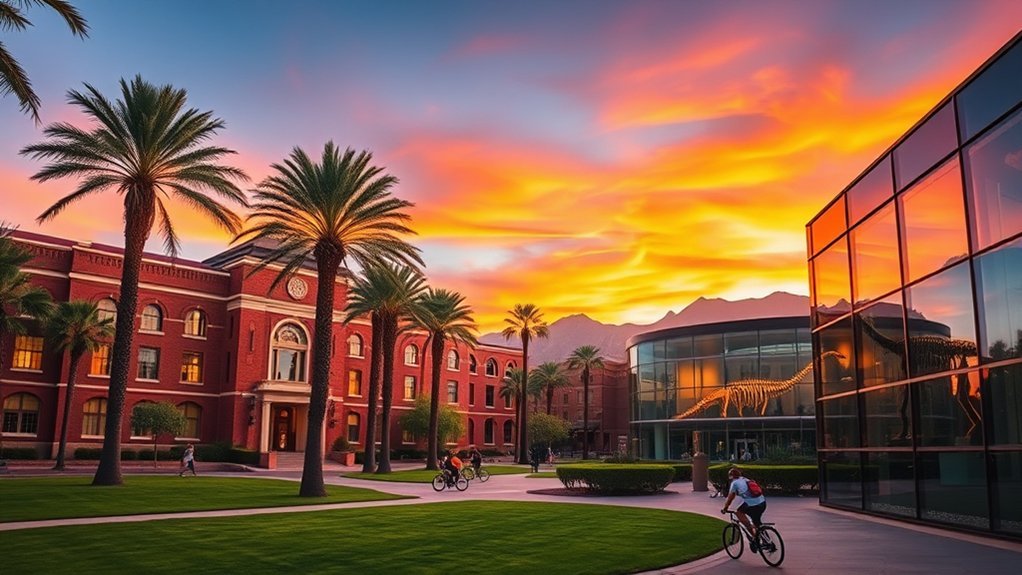
Step onto the University of Arizona campus and you’ll immediately notice a lively mix of historic brick, modern glass, and shady palms that make wandering between museums feel like moving through Tucson’s cultural heart. You’ll follow wide, tree-lined pathways past students and public art, arriving at museums that span science, art, and regional history. At the Arizona State Museum you’ll see Indigenous collections and rotating exhibits that contextualize Sonoran life; the Center for Creative Photography houses iconic images and archival research spaces you can browse. Don’t miss the Flandrau Science Center’s hands-on planetarium shows—tickets often sell out, so check schedules. You’ll appreciate campus hours, guided tour options, and occasional public lectures that enrich a museum visit. Nearby cafés and benches invite you to pause and reflect on exhibits. Allow time to drift between buildings; the campus itself teaches through architecture, collections, and the lively exchange between students, scholars, and visitors curious about Tucson’s layered past and creative present.
Experience the Tucson Botanical Gardens
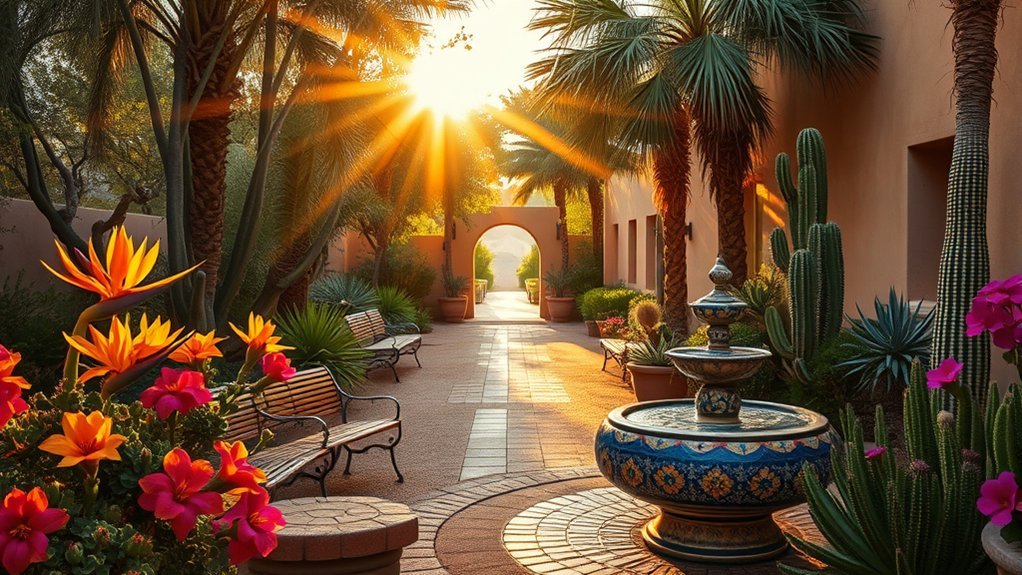
When you enter the Tucson Botanical Gardens, you’ll find a surprising patchwork of themed gardens—desert, butterfly, herb and more—woven through shady paths and intimate courtyards that invite slow exploration. You’ll wander among succulents clinging to sun-baked rock, pause where monarchs hatch in a protected enclosure, and catch the scent of rosemary and lavender in the herb garden. Volunteers and staff often share stories about rare cacti or sustainable water practices, so you’ll learn as you stroll. Benches and small fountains create pockets for sketching or quiet observation. Seasonal exhibits and workshops mean each visit can feel new, whether you’re photographing blooms or noting bird species drawn to native plantings.
- A sunlit courtyard with trailing bougainvillea
- Sculpted agave silhouettes at golden hour
- A netted butterfly house alive with orange wings
- Narrow brick paths lined with fragrance-filled herbs
- A shaded pool reflecting palm fronds
Eat Sonoran-Style Tacos in a Local Taquería
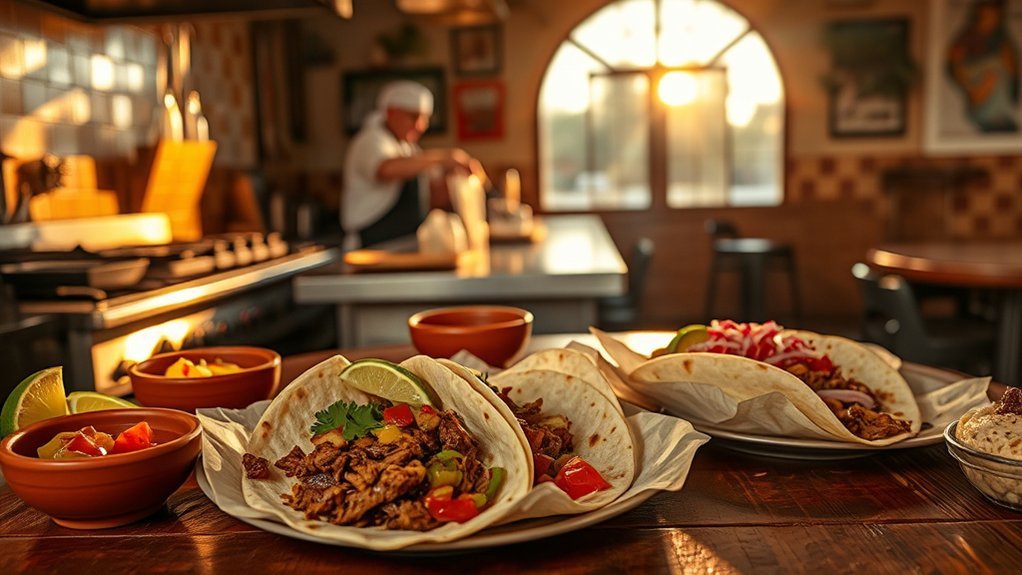
After wandering the fragrant paths of the Botanical Gardens, you’ll find your appetite steering you toward a different kind of local ritual: a bustling taquería serving Sonoran-style tacos. You step inside to the clang of metal, the sizzle of meat, and an immediate sense that food here is family business. Order carne asada, al pastor, or the regional staple—soft flour tortillas folded around grilled meat, melted cheese, and charred green chiles. Watch the cook press dough on a comal, flip ingredients with practiced speed, and ladle beans rich with rendered fat. You’ll notice toppings laid out like small altars: pickled onions, fresh cilantro, lime wedges, and house-made salsa ranging from bright and citrusy to slow-building heat. Eat standing at the counter or on a sun-warmed bench outside, folding the taco with both hands. You’ll leave with a full belly and a clearer sense of Tucson’s culinary soul—direct, unpretentious, and utterly satisfying.
Attend a Performance at the Rialto Theatre
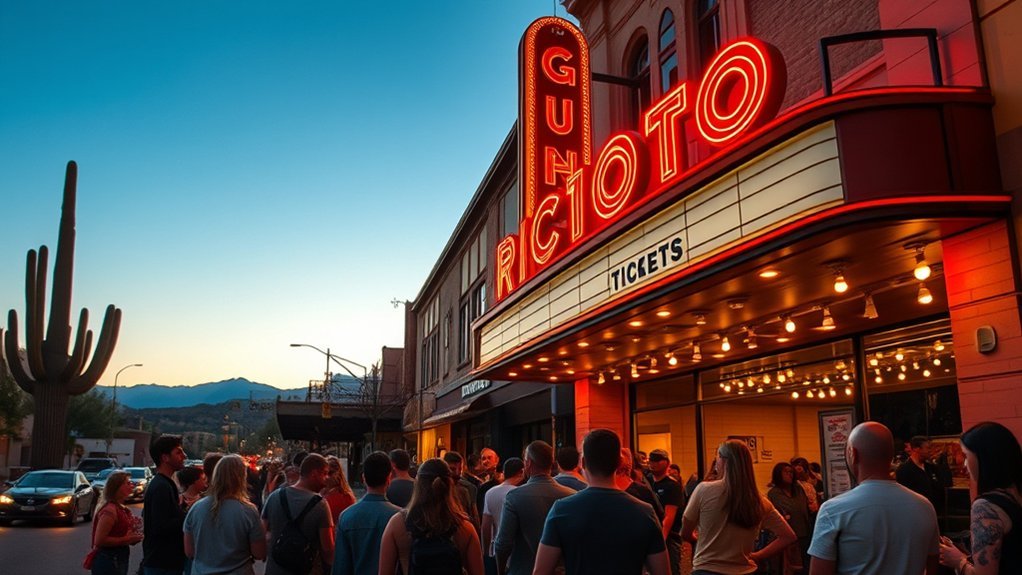
You’ll feel the Rialto’s history as soon as you step into the restored movie palace with its ornate ceiling and marquee lights. The venue hosts everything from indie bands to comedy nights, so check the schedule for current live music and special events. It’s a lively spot where Tucson’s old‑time charm meets contemporary performance.
Historic Movie Palace
Stepping into the Rialto Theatre feels like entering a time capsule of Tucson’s golden age: ornate plasterwork, vintage chandeliers, and a marquee that still glows with hand-set letters. You’ll notice the deep velvet seats, the gentle slope toward a proscenium framed in gilded detail, and the original projector booth perched like a small observatory. Staff offer programs and context, so you learn the building’s 1920s origins and restoration choices as you settle in. The atmosphere primes you for cinema history or a staged screening—this is about filmic spectacle and architectural theatercraft rather than contemporary concert energy.
- velvet seats worn smooth by decades of audiences
- terrazzo floors reflecting chandelier light
- hand-painted murals along the ceiling
- brass railings warmed by touch
- a small, intimate stage proscenium
Live Music & Events
Catch a live show at the Rialto and you’ll feel the building wake up—its vintage lights, plush seats, and echoed acoustics turning an ordinary night into something cinematic. You enter through a narrow marquee, ticket in hand, and notice the painted ceiling and ornate plasterwork that hint at decades of performances. Musicians command the stage with intimate presence; spoken-word nights make the room lean in. The Rialto programs indie bands, touring acts, comedy and film events, so you can time a visit to match your taste. Concession lines move quickly, staff are friendly, and the sound team balances clarity with warmth. After the final encore, you step back into Tucson’s streets, still humming, a city slightly transformed.
Drive or Bike the Loop Multi-Use Paths
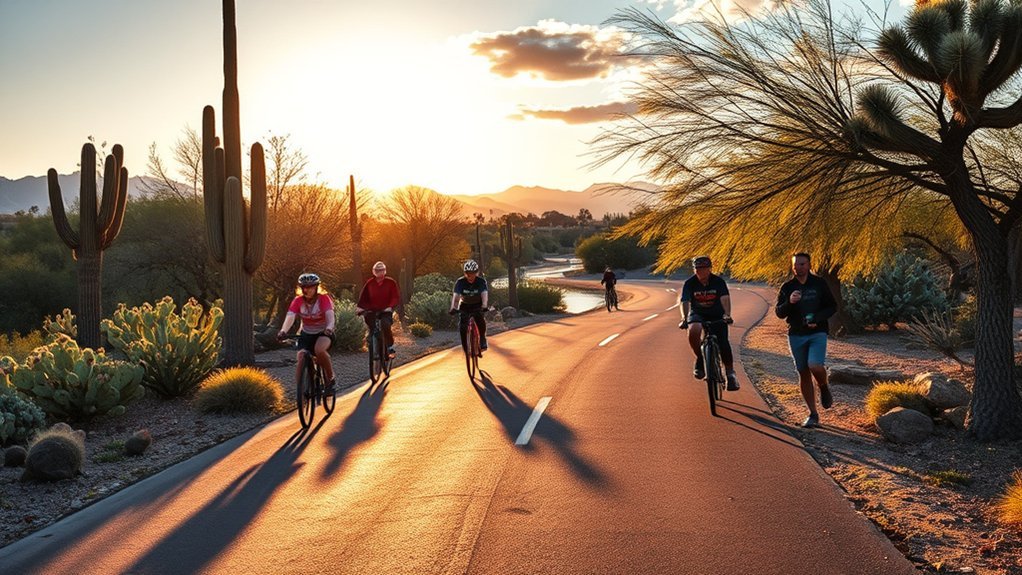
Often you’ll find locals and visitors sharing the shaded stretches of The Loop, a connected network of paved bike and walking paths that circles Tucson and links parks, museums, and neighborhoods. You’ll choose whether to pedal a rental bike or drive to a trailhead, then glide past citrus groves, canal banks, and sun-dappled mesquite. The design makes it easy to hop off for coffee, a picnic, or birdwatching; mile markers and maps keep you oriented. You’ll notice runners pacing each other, families pausing at art installations, and commuters using the path for a calm, car-free route.
- A long canal lined with cottonwoods and early-morning cyclists
- A quiet pocket park where you can stretch and sip coffee
- Sculptural benches and murals signaling a neighborhood turn
- A desert wash brimming with seasonal wildflowers
- Sunset light painting saguaro silhouettes as you coast home
Bring water, light, and a pump — The Loop invites exploration at any pace.
Explore the Presidio Historic District
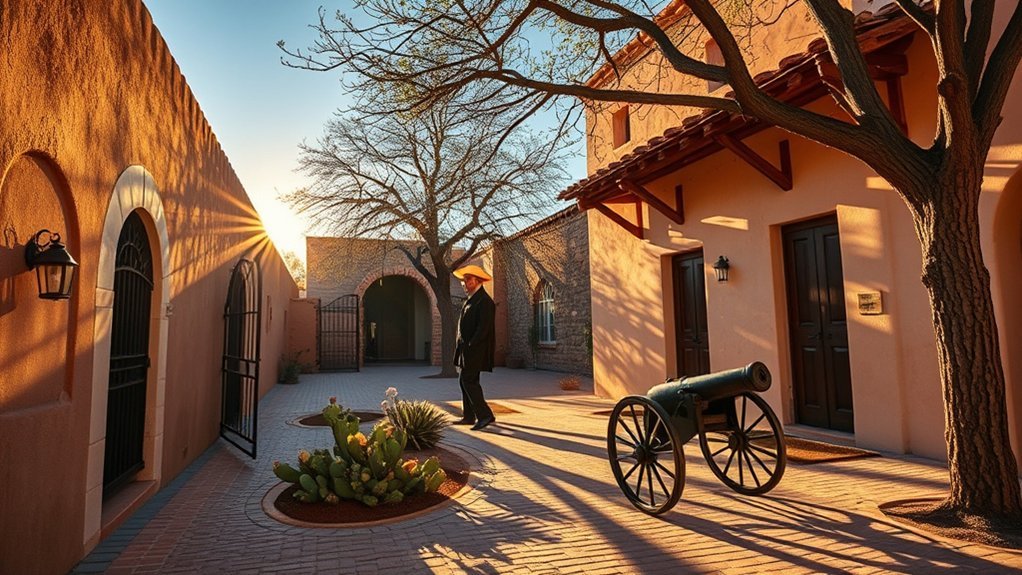
Walk down the shaded streets of Tucson’s Presidio Historic District and you’ll find layers of the city’s past stitched into adobe walls, narrow alleys, and sun-warmed plazas. You’ll notice restored 18th-century buildings, interpretive plaques, and quiet courtyards that invite slow exploration. As you turn a corner, imagine horse hooves on packed earth and merchants setting up shop; the neighborhood’s layout still follows those old rhythms. Stop at a small museum or gallery to see artifacts and maps that clarify Tucson’s Spanish, Mexican, and territorial chapters. You can join a guided walk or wander on your own, listening for the creak of wooden doors and the murmur of locals in cafés. The district’s scale keeps history human—close enough to touch but preserved thoughtfully. Before you leave, pause in a plaza to watch light shift across stucco; it’ll give you a clearer sense of how place and memory shape the city.
| Feature | Why it matters |
|---|---|
| Adobe buildings | Authentic materials |
| Museums | Context and artifacts |
| Guided walks | Local stories |
| Plazas | Everyday life preserved |
Stargaze at Kitt Peak National Observatory
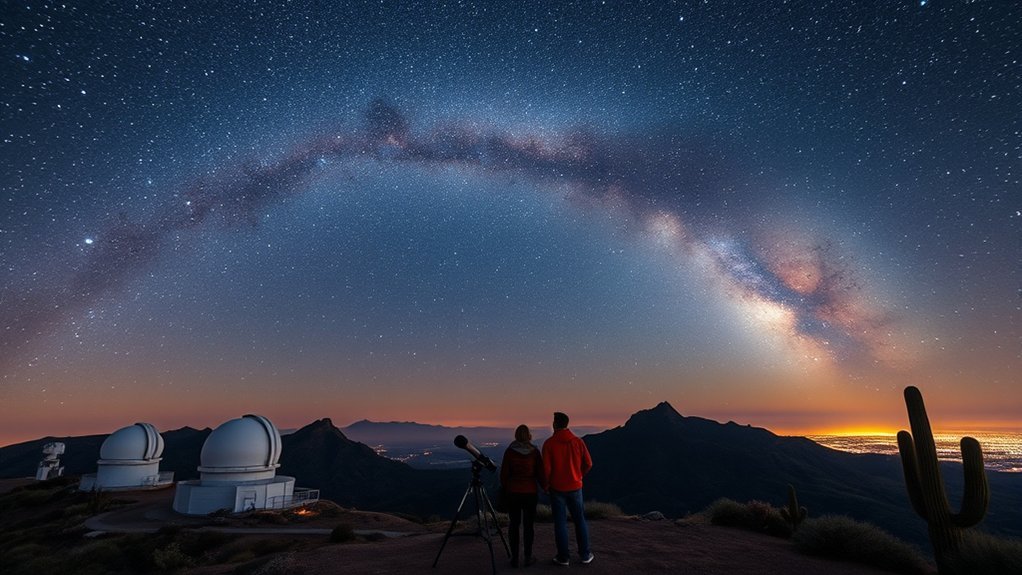
Head up from the city lights to Kitt Peak National Observatory and you’ll find an otherworldly hush punctuated by the slow swivel of massive telescopes and the whisper of night wind through desert scrub. You’ll walk along paved paths where guides point out constellations and explain how the dry air and elevation sharpen stellar views. At a dome, a technician lifts a slit and you peer through an eyepiece to see craters on the Moon and distant galaxies as smudges of light. The experience blends science and solitude: instrument panels glow, people lower their voices, and you learn practical tips for night photography and respecting dark-sky etiquette.
Head away from city glow to Kitt Peak’s hush—swiveling telescopes, desert wind, and starlight sharpened by high, dry air
- Cool, crisp air carrying creosote and juniper scents
- Stars clustered so densely they look like spilled salt
- Reflective telescope housings catching moonlight
- Quiet conversations punctuated by guide announcements
- Trails lit only by red flashlights to preserve night vision
Wander Through the Mercado San Agustín
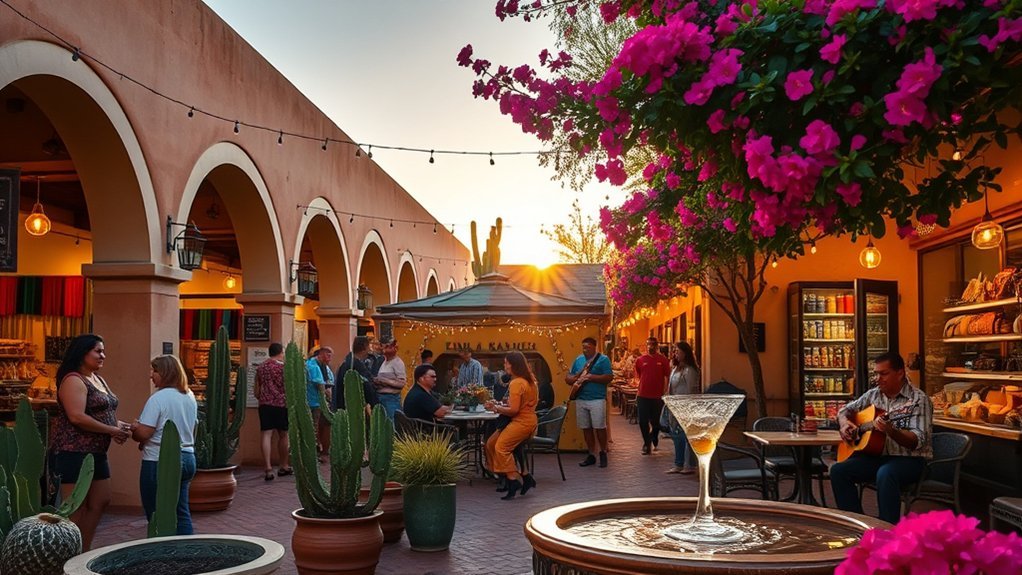
Step into Mercado San Agustín and you’ll immediately feel the pulse of Tucson’s creative heart: local artists, food vendors, and pop-up shops share a sunlit courtyard where murals, handmade jewelry, and craft beers invite you to linger. You’ll wander between stalls, spotting ceramicists shaping small vases, screen printers layering bold designs, and photographers selling desert prints. Pause at the bar to sample a local brew or buy a cold-pressed juice, then follow the scent of freshly baked tortillas to a vendor rolling masa by hand. Notice the architecture — preserved brick and open-air walkways that keep things airy in summer and cozy in winter. Pay attention to event boards; Mercado hosts live music, artisan markets, and family-friendly workshops. If you want a keepsake, ask artists about their process; they’ll tell you where materials come from and why certain motifs matter here. You’ll leave with more than purchases — you’ll leave with a sense of Tucson’s makers and their stories.
Take a Guided Mexican Food or Margarita Tour

Explore Tucson’s rich culinary tapestry on a guided Mexican food or margarita tour that threads together family-owned taquerías, hole-in-the-wall bakeries, and cantinas where recipes have been passed down for generations. You follow a local guide who explains regional ingredients—chiltepín, mesquite, cotija—and shows you how Tucson’s Sonoran-style flour tortillas differ from others. You’ll sample carne asada tacos blistered on a flat top, sip smoky margaritas rimmed with local citrus, and stop at a panadería for conchas still warm from the oven. The guide points out neighborhood histories tied to each storefront, so food becomes a map of culture and migration. Tours vary in pace and focus; pick one that matches your appetite and mobility. Expect 3–6 tasting stops, clear notes about dietary needs, and tips on ordering like a local. You walk away with new flavors, context for what you tasted, and a shortlist of places to return to on your own.
- Steaming tortilla pressed by hand
- Bright lime and sea-salt rim
- Sweet concha sugar crust
- Charred salsa in a clay cazuela
- Warm, fragrant coffee from the corner shop
Visit the Pima Air & Space Museum
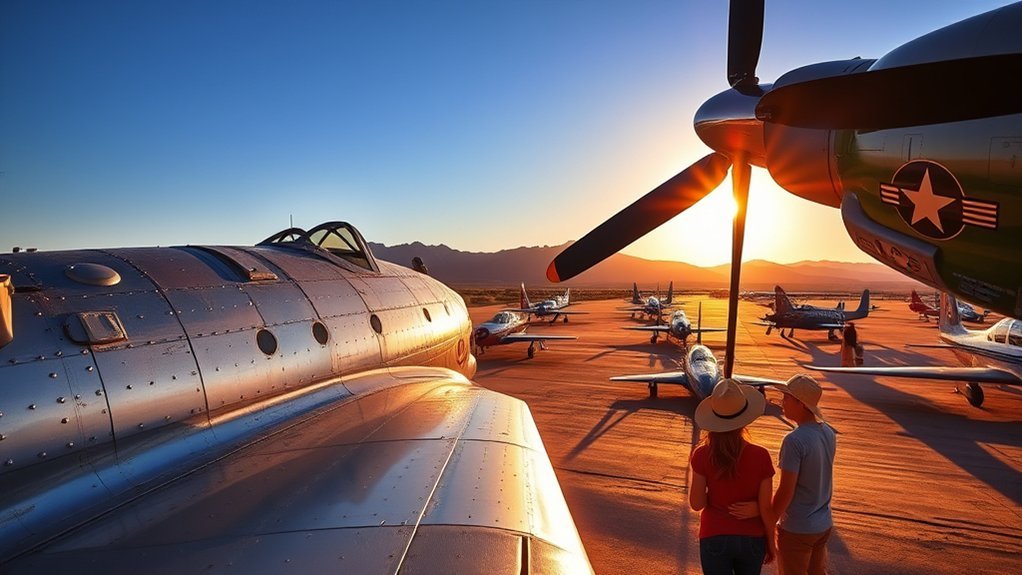
A stroll through the Pima Air & Space Museum feels like walking through aviation history: you’ll pass rows of restored fighters, jumbo jets, and rare prototypes spread across vast desert tarmac, each with placards that tell who built it, where it flew, and why it mattered. You’ll notice the scale first—the wingspans, the polished tails—and then the small human touches: mission markings, faded nose art, maintenance notes. As you move between hangars, docents share stories about aircraft rescued from scrapyards and pilots who logged dangerous sorties. Interactive exhibits let you climb into cockpits and compare avionics across eras, so you can see how technology evolved from analog dials to digital glass. Don’t miss the restoration bays, where volunteers carefully strip paint and repair rivets; watching a plane come back to life is unexpectedly moving. Plan at least two hours, check for guided tours or special exhibits, and bring a camera—the light over the desert metal is unforgettable.
Explore Mount Lemmon and the Sky Islands
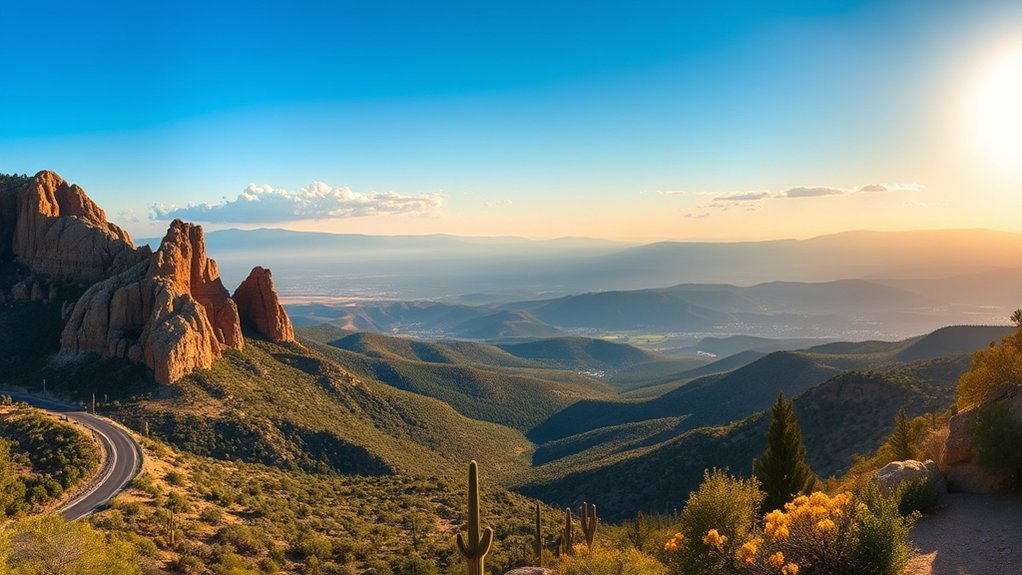
Drive up the Mount Lemmon Scenic Drive and you’ll watch the desert give way to pine forests and cooler air. You can stop at pullouts for quick views or park and follow Sky Island hiking trails that weave through surprising ecosystems. Along the way you’ll notice how elevation changes bring new plants, birds, and sweeping vistas worth lingering for.
Mount Lemmon Scenic Drive
When you climb the winding Catalina Highway toward Mount Lemmon, the landscape shifts so quickly it feels like crossing into another climate zone — desert scrub gives way to pine forests and granite outcrops, earning these peaks the nickname “Sky Islands.” You’ll drive a scenic ribbon of switchbacks, pullouts and viewpoints that reveal Tucson below, cooler air, and sudden stands of aspens. The route’s readable geology and changing vegetation tell a story of elevation and rainfall. Stop at overlooks to scan for jays, hawks and distant saguaros dotting the valley. Facilities are limited higher up, so plan water and fuel. The road itself is the attraction: a compact tour of ecosystems, geology and atmosphere without leaving your car.
- Winding road framed by ocotillo and palo verde
- Sudden pine groves and rocky cliffs
- Panoramic views of Tucson basin
- Cooler, crisp mountain air
- Small pullouts with interpretive signs
Sky Island Hiking Trails
Climbing into the Sky Islands on foot, you’ll feel the temperature and vegetation change with each switchback as desert scrub gives way to oak and pine—an immediate, living lesson in elevation-driven ecosystems. You follow narrow trails that thread granite outcrops, creek beds and shaded canyons, noticing bird calls and the sudden scent of resin. On Mount Lemmon, choices range from short nature loops to strenuous ridgeline hikes; trailheads like Marshall Gulch and Aspen Draw offer clear signage and water sources in season. Pack layers, sun protection and plenty of water; start early to avoid afternoon storms and to catch light on saguaros below. Hike respectfully, stick to established paths, and you’ll leave with clearer air, cooler temps and striking views.
Go Birdwatching in the Sweetwater Wetlands
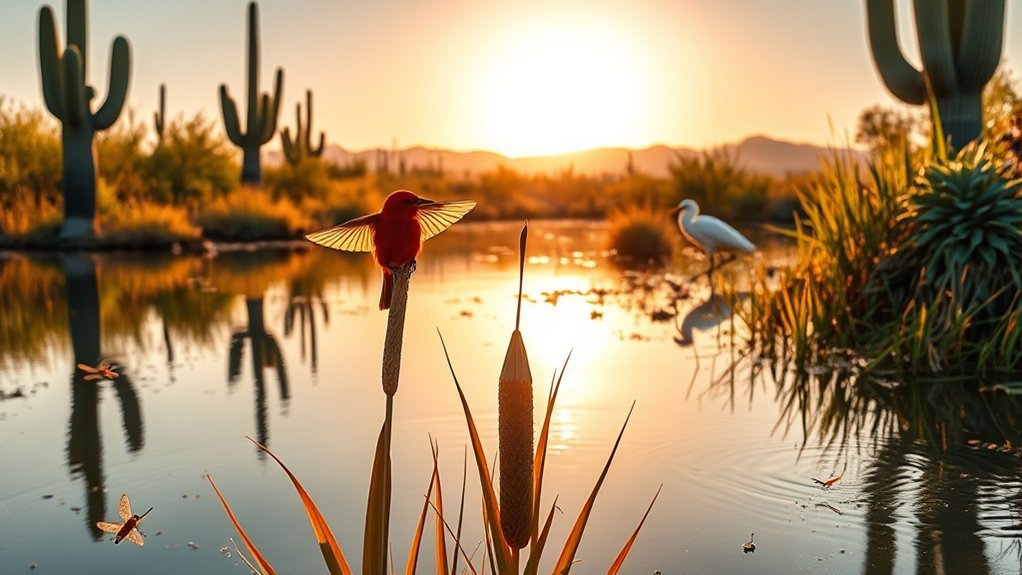
Often overlooked by visitors, the Sweetwater Wetlands offers a compact, easy-to-walk refuge where you can spot dozens of bird species without straying far from downtown Tucson. You’ll follow shaded boardwalks and pause where water pools attract shorebirds, herons, and occasional raptors. Morning light turns reed edges golden and reveals songbirds flitting through mesquite; evenings bring quiet reflections and silhouettes against the sky. Binoculars and a small field guide will turn vague shapes into identifiable residents and migrants. You’ll learn to read calls, watch feeding behavior, and time visits around migration peaks for the best diversity. Trails are stroller-friendly and educational signs explain habitat restoration, so you’ll understand how urban wetlands support wildlife. Keep an eye out for seasonal highlights and bring water, sun protection, and a camera.
- A greenbelt lined with cattails and low reeds
- Little blue herons stalking shallow edges
- Kingfishers zipping between branches
- Yellow warblers flicking among mesquites
- Sunset reflections on mirror-flat pools
See Contemporary Art at the Tucson Museum of Art
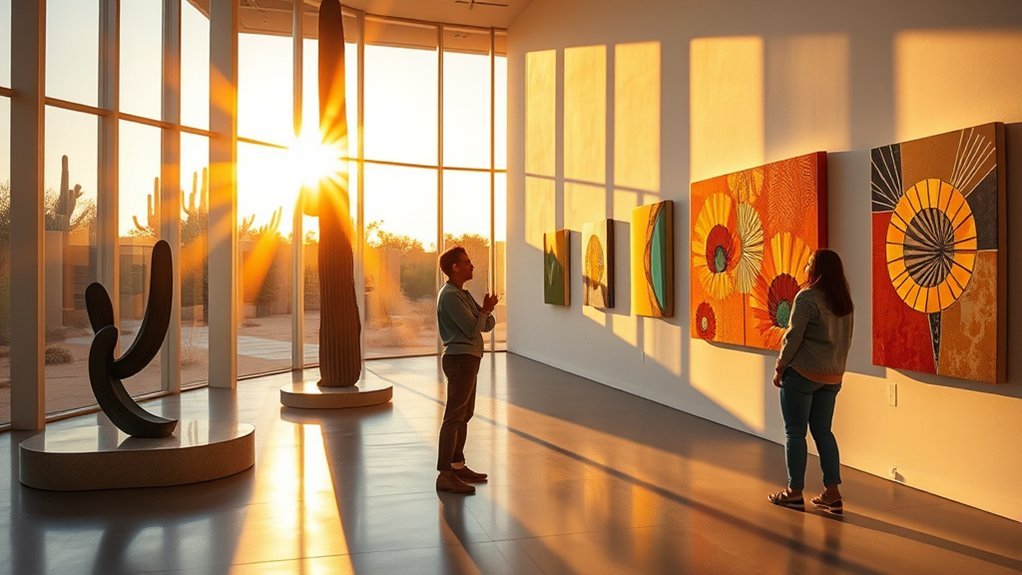
Curious what’s shaping Tucson’s creative pulse? You’ll find it at the Tucson Museum of Art, where rotating exhibitions and a strong contemporary collection reveal the city’s visual conversations. Walk through light-filled galleries that pair local voices with national and international artists; you’ll notice materials, motifs, and desert themes that echo Tucson’s landscape and cultures. Docents offer context, so join a tour to learn about techniques and the stories behind works. Temporary shows change often, so check the calendar before you visit and plan time for the museum’s sculpture garden and courtyard—quiet spots to reflect. The museum’s shop features prints and crafts from regional makers, perfect if you want a tangible reminder. Exhibitions often include artist talks or workshops; attending one connects you directly with creators and gives insight into process. Whether you’re an art novice or a seasoned viewer, the museum frames contemporary practice in ways that feel both accessible and provocative.
Sip Craft Beer at Local Breweries
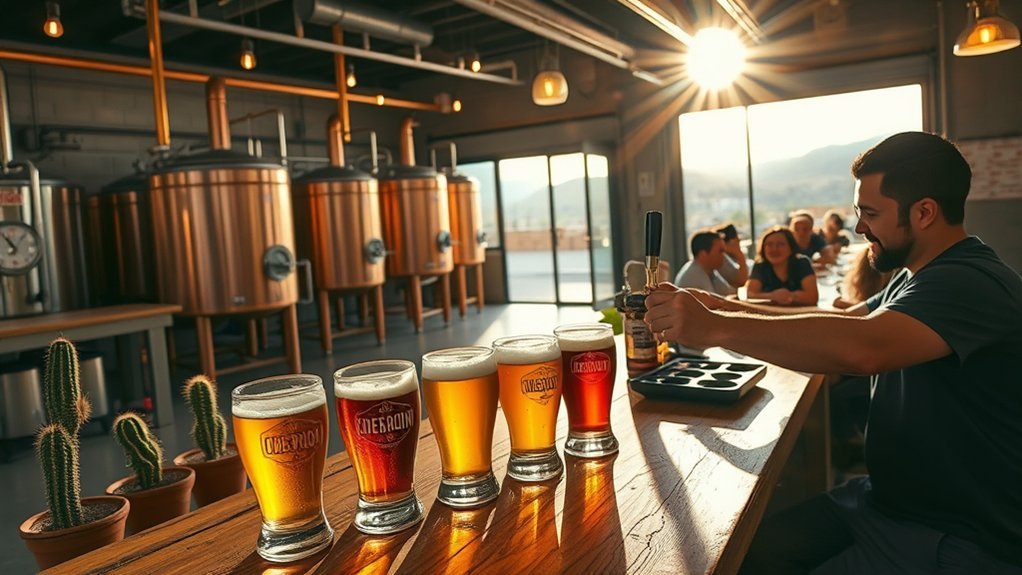
After soaking up art and desert stories at the Tucson Museum of Art, head out to explore the city’s lively craft-beer scene—it’s another way to read local culture, this time through flavor and small-batch production. You’ll find taprooms where brewers talk shop, patios with desert breezes, and seasonal ales that nod to Sonoran ingredients. Try a hazy IPA beside someone sketching saguaro silhouettes, or sample a chile-infused porter that makes you notice regional spice in a new way. Ask about grain sources and water treatment; conversations reveal care and community. Walk between breweries to see changing neighborhoods, and pick up a growler to enjoy at sunset. The scene feels handcrafted and conversational, not touristy—brewers and patrons trade stories like postcards.
After museum tales, wander Tucson’s taprooms—mesquite-shaded patios, experimental brews, and conversations poured like postcards.
- Rusted tin patios shaded by mesquite trees
- Copper taps gleaming behind polished wood bars
- Flight paddles lined with amber gradients
- Chalkboards listing weekly experimental brews
- Laughter mixing with the clink of pint glasses
Tour the DeGrazia Gallery in the Sun
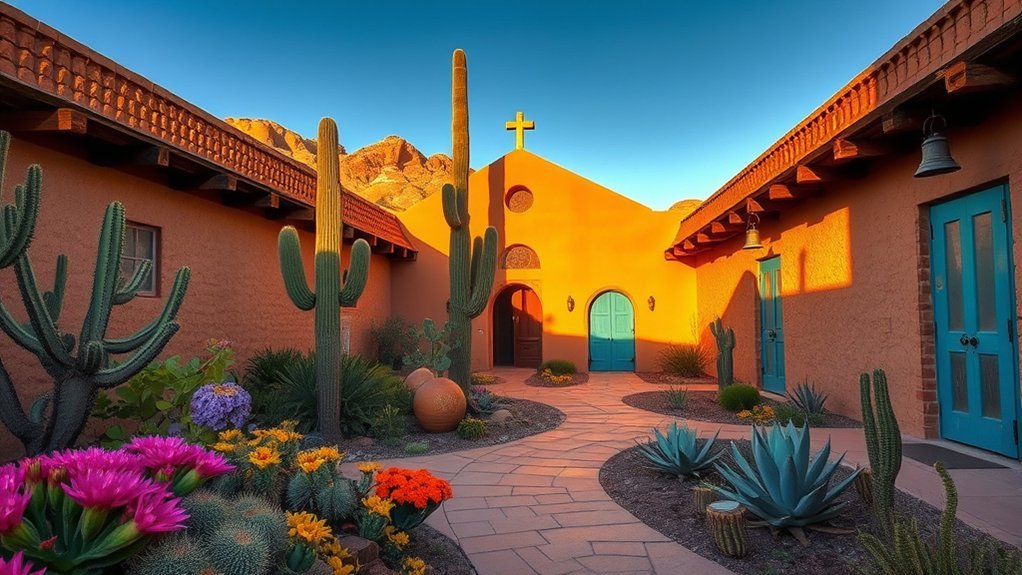
When you step through the low adobe archways at the DeGrazia Gallery in the Sun, the courtyard’s quiet light and handmade tiles feel like a pause from the city—an intimate world shaped by artist Ted DeGrazia’s vision. You wander among low-slung buildings he designed, each painted with his distinctive, folk-inspired murals and sun-baked palettes. Notice the chapel, simple and serene, where stained glass and woodwork reflect his devotion to community and craft. As you move through galleries and outdoor nooks, placards explain techniques, influences, and DeGrazia’s ethos of accessibility—he wanted art for everyone. You’ll see original paintings, sketches, and ceramics, plus the artist’s own living spaces preserved nearly as he left them. Guided tours reveal anecdotes about his teaching, exhibitions, and the property’s conservation. Before you leave, pause beneath the palms to take in the Sonoran light; the place feels less like a museum and more like a lived, breathing studio where art and everyday life meet.
Attend the Tucson Gem and Mineral Show (seasonal)
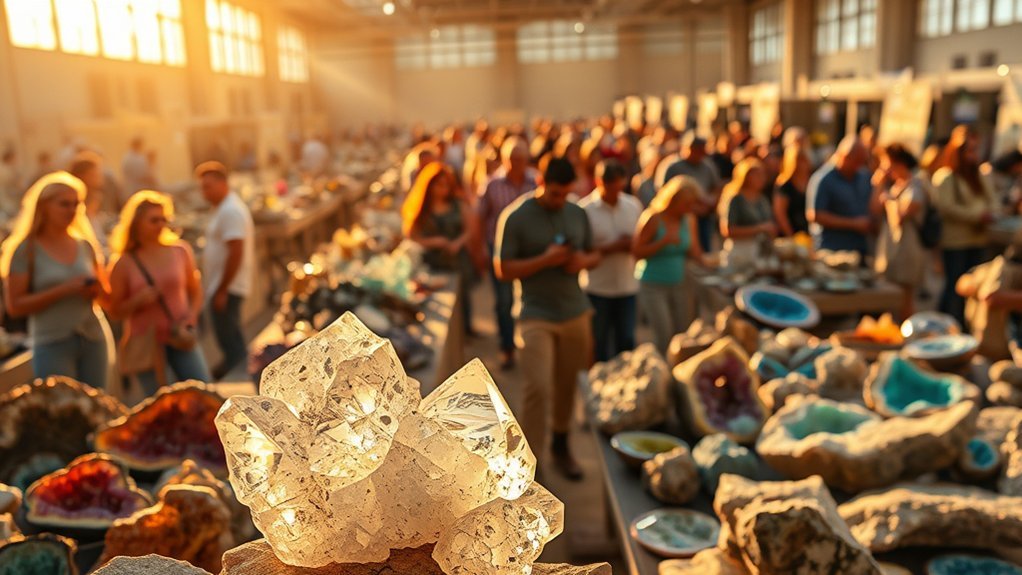
When you hit the Tucson Gem and Mineral Show, you’ll feel the weight of its long history in every glittering case and marquee event. Walk through standout exhibits showcasing rare minerals and museum-quality specimens, then circle the bourse for pieces you can actually buy. I’ll also share practical tips on bargaining, spotting authentic gems, and timing your visit to get the best finds.
Show History Highlights
Although the Tucson Gem and Mineral Show only takes over the city for a few weeks each year, you’ll feel its history the moment you step into any showroom or street fair. You trace lines back to miners, dealers and collectors who turned a winter gathering into the world’s premier mineral marketplace. You’ll notice veterans comparing notes, families passing treasures down, and catalogs that read like time capsules. The show maps industry shifts—from hand-dug specimens to museum-grade displays—and reflects Tucson’s role as a global crossroads for geology and culture. Pay attention to plaques, dealer stories and the layout of older venues; they tell how taste, trade routes and science shaped what you see.
- Sunlit tables of labeled crystals
- Weathered hands sorting specimens
- Dusty maps of old mining claims
- Handwritten sale ledgers
- Vintage display cases
Best Exhibits to See
The stories you noticed in older showrooms and on dealer placards lead naturally to the displays you won’t want to miss: museum-grade mineral cases, themed room exhibits, and live-cutting demonstrations that bring those histories alive. You’ll move from glittering specimen halls into curated galleries where labels explain formation, locality, and rarity, so you understand why a crystal’s color or habit matters. Don’t skip the thematic rooms—Arizona minerals, meteorites, and lapidary art each tell a focused story. Watch cutters and polishers at work; the rhythm of saws and laps turns rough stones into gems before your eyes, revealing techniques and patience. Time your visit to public lectures and guided tours to deepen context and spot rare pieces.
Buying and Bargaining Tips
If you plan to buy at the Tucson Gem and Mineral Show, go in with a game plan and a few clear priorities so you don’t get overwhelmed by the sheer volume and variety. Walk slowly, eyeing displays, and let a few stands draw you in—learn to spot quality, ask about provenance, and check crystals under good light. You’ll haggle politely: start lower than your top price, mention comparable pieces, and be ready to walk away. Carry small bills, a loupe, and a notebook. Trust your gut on color and symmetry; avoid impulse buys just because something’s rare.
- sunlit tables piled with gleaming amethyst clusters
- velvet-lined cases of faceted gems
- weathered dealer tags and friendly banter
- tiny labels reading locality and age
- crowded aisles with traders inspecting stones
Ride the Sun Link Streetcar and Visit Downtown
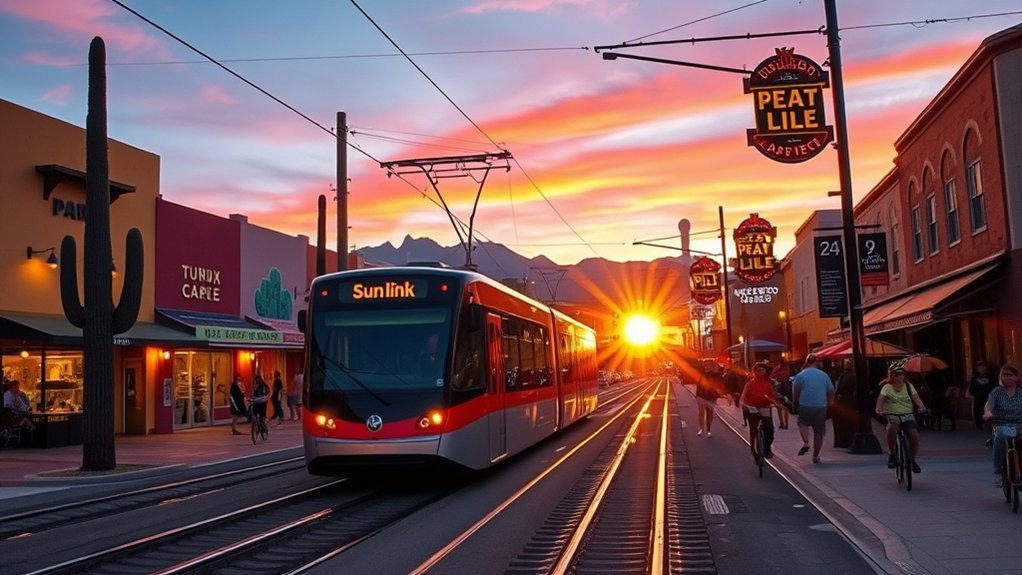
Hop on the Sun Link streetcar and you’ll glide through Tucson’s vibrant downtown, where historic theaters, public art, and lively cafes sit just steps from the tracks. You’ll watch storefronts change from mid-century facades to modern glass as the car hums along; locals hop on for work, students board with backpacks, and tourists linger near the windows, spotting murals and pocket parks. Get off at the 4th Avenue or Congress stops to wander boutiques, bookshops, and food trucks; follow signage to the Presidio District for brick streets and interpretive plaques. Timing’s simple—cars run frequently and fares are easy to pay on board or with a mobile app. If you prefer biking, several shared-bike docks sit close to stops. Keep an eye on schedules during special events that extend hours or add service. Ride the line as a convenient, relaxed way to connect neighborhoods, sample downtown dining, and map out the rest of your Tucson day.
Discover Native American History at the Tohono O’Odham Cultural Center
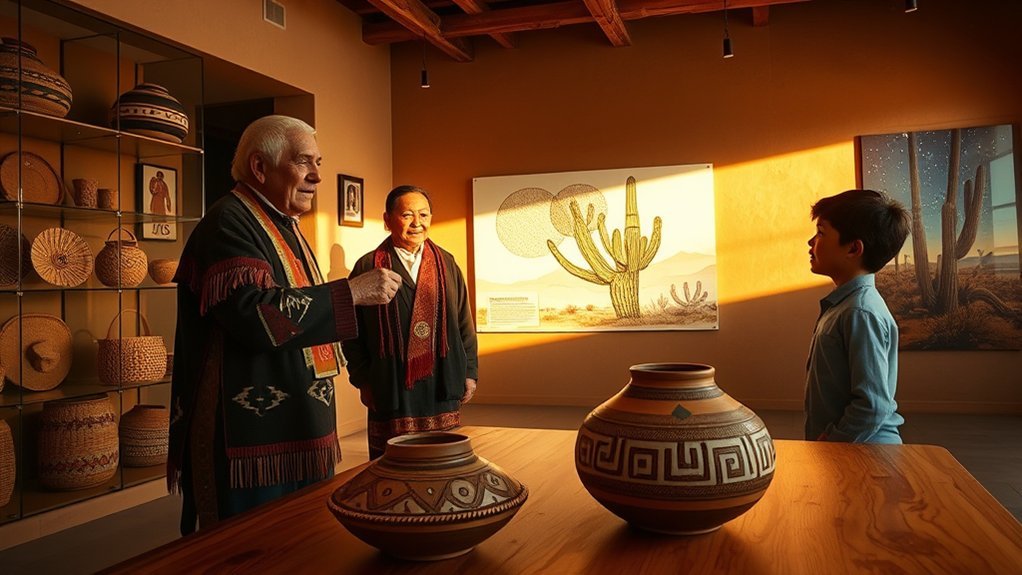
When you step into the Tohono O’odham Cultural Center, you’ll immediately sense how living traditions and contemporary life intertwine through exhibits, stories, and artifacts. You’ll follow a guided route that moves from historical context to present-day community initiatives, hearing elders’ voices on audio panels and seeing basketry, pottery, and textiles up close. The layout invites you to pause at personal stories—family photos, seasonal calendars, and language revitalization projects—that make history feel immediate. Staff and volunteers answer questions, and you’ll leave with a clearer sense of Tohono O’odham resilience and creativity.
- Sun-warmed desert maps showing migratory routes and seasonal camps
- Intricate coiled baskets with natural-dye patterns and worn handles
- Photographs of harvests and communal celebrations under wide skies
- Audio stations playing traditional songs and contemporary interviews
- Display cases of seed varieties, tools, and hands-on weaving samples
Plan for a couple of hours to read, listen, and reflect; the center rewards thoughtful exploration.
Take a Hot Air Balloon Ride Over the Sonoran Desert
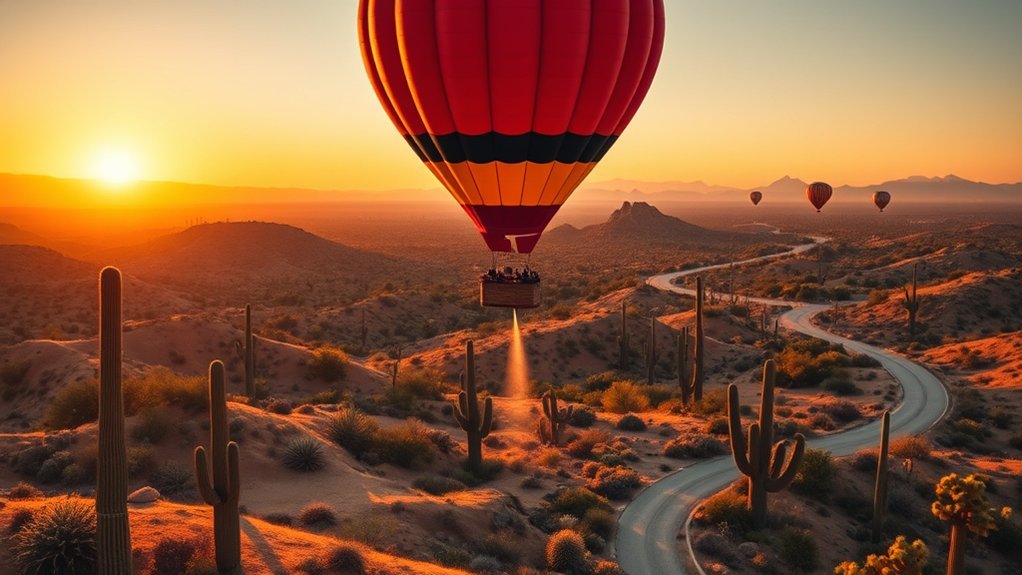
Glide above the Sonoran Desert at dawn and watch saguaros, washes, and distant mountain ranges shrink into a painterly patchwork as the balloon lifts you into the cool, golden air. You feel the gentle sway, hear the occasional roar of the burner, and notice how shadows slide across the valley floor. Pilots point out landmarks—the Santa Catalina foothills, riparian corridors, and ancient petroglyph sites—while explaining wind patterns and seasonal blooms. Photographs capture broad vistas, but being aloft gives you depth: the desert’s textures, creosote patterns, and the unexpected ribbon of a dry riverbed. Most flights last about an hour; operators include sunrise launches, safety briefings, and soft landings assisted by crew. Wear layers, bring a camera, and book early in cooler months when conditions are ideal. If you want a quiet, unforgettable perspective on Tucson’s landscape, a hot air balloon ride delivers calm, clarity, and a fresh appreciation for the Sonoran Desert’s scale.
Frequently Asked Questions
What’s the Best Time of Year to Visit Tucson for Mild Weather?
Late fall through spring is best for mild weather; you’ll enjoy cool mornings and warm afternoons from October to April. You’ll dodge summer heat, savor clear skies, and have ideal conditions for hiking, sightseeing, and outdoor meals.
Are There Reliable Public Transit Options for Reaching Major Attractions?
Birds of a feather flock together — you’ll find decent bus and Sun Link streetcar service to many attractions, but routes can be sparse; you’ll plan rides, mix transit with rideshares, and expect occasional waits.
Is Tucson Safe for Solo Travelers Walking at Night?
It can be safe, but you shouldn’t assume it. You’ll findwell-lit, busy areas are fine; avoid isolated streets, trust instincts, keep valuables hidden, use rideshares at night, and ask locals or hotel staff for current safety tips and routes.
Can I Bring My Dog to Outdoor Parks and Trails?
Yes — you can bring your dog to many outdoor parks and trails, but you’ll need to follow leash rules, pick up waste, watch for heat and wildlife, and check individual park regulations before heading out.
Do I Need Reservations for Popular Restaurants and Tours?
Like snagging a rare bloom, yes — you’ll often need reservations for popular restaurants and tours. Plan ahead, book online or by phone, and arrive early; busy spots fill fast, especially evenings and weekend dates.
Conclusion
So you came for saguaros and tacos and stayed for sunsets and serendipity — classic tourist wisdom. You’ll climb desert trails, sample Sonoran flavors, and pretend you’re the only one who noticed the Milky Way at Kitt Peak. Tucson keeps surprising: a small city with big skies, quieter history, and stubborn charm. Go ahead, explore every canyon and mercado; the place will still feel like you discovered it, even when everyone else has.

